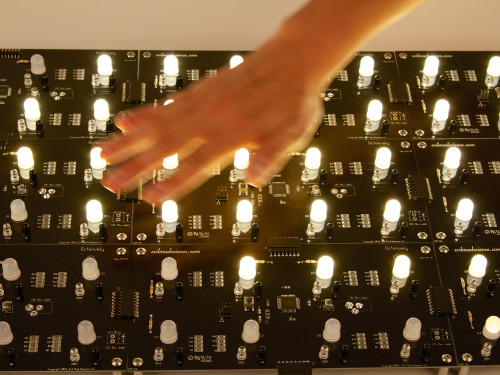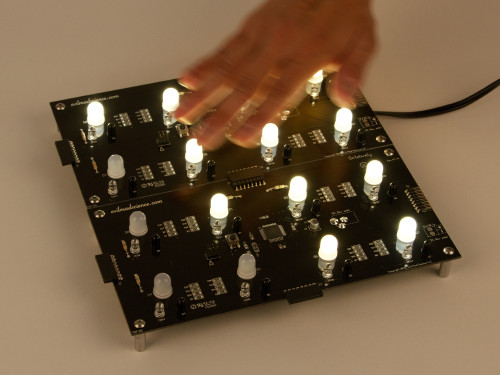Last year we released Octolively, an open source interactive LED kit, designed to respond in gentle and complex ways to stimulus provided by human interaction.
While Octolively has been a success (and a lot of fun), thus far it has only been available as a soldering kit. Today, we’re pleased to supplement those with a new version: prefabricated Octolively modules, all built-up and ready-to-use, so you can jump right in and start playing with the LEDs.
Like the soldering kit version, each “prefab” Octolively module is 4 × 8 inches (10.16 × 20.32 cm) in size, and features eight huge (10 mm) ultrabright LEDs, spaced along a two-inch grid. And, for every LED, there is an independent infrared proximity sensor pair, configured to act as a reflective motion sensor.

The most obvious change from the soldering kit version of Octolively is that the topside components take up a lot less space. All of the resistors, capacitors, and the microcontroller have been replaced by their surface mount equivalents.
However, this not really a “surface mount” circuit board, it’s more accurately a “mixed technology” board. Some of the components— in particular many “optoelectronic” components, like our visible and infrared LEDs —just don’t have great surface mount versions. For example, when we’ve tried building motion sensors circuits with SMT infrared LEDs (even the pricier types that have itty-bitty lenses) we found that they just didn’t project enough IR light to be effective. Similarly, we’ve found that visible surface mount LEDs tend to be perceived as dim, even when a huge amount of light is being emitted, because the light usually goes into a very wide angle.
The microcontroller is an Atmel ATmega164A, in the 44-pin TQFP package. (And in case you’re wondering, yes that’s exactly as redundant as “ATM machine.” )
Those white gumdrop-looking things are (as before) the big 10 mm LEDs, but they certainly seem even bigger sitting next to that chip.
Ready-to-use Octolively modules are available now at Evil Mad Science.
Additional details— including the datasheet and documentation links —are available on the product page.









Guys: while I like the stuff you did in the past your last months have been “dump” posts.
Move on! you really love making, right?
While I understand where you’re coming from, we really have been making stuff, and it takes time. We’ve often noticed an approximate inverse relationship between the amount of time that we put into a project and how much time it is perceived to have taken. And lately, we’ve been working on some bigger, longer-term projects. This won’t always be the case.
If you actually look at what we’ve done here (designing a new version of our Octolively boards, prototyping, testing, sourcing, fabricating, programming, testing, writing documentation, photographing, preparing design files for release, and finally blogging about it) this was actually about a 3-4 week project, spread over the course of six months. Making is a process, and making stuff that works well takes a lot of time, often behind the scenes. Yes, we could split this into twenty little blog posts about the process. But that isn’t (usually) how we roll.
Thank you Windell for your answer.
You’re right. It’s definitively a lot of work. My bad.
PD: I apologize for the rudeness of my previous post, I didn’t notice i was being quite a troll.
Thanks for your understanding; no hard feelings. ;)
I’m pretty sure the answer to this is obvious, but I assume that the pre-fab Octolively modules will mix-and-match with the soldering kit so that an array of existing kits can be expanded by adding pre-fabs etc.
Yes, they will mix and match just fine.